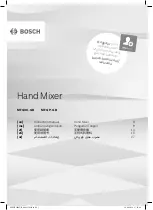
B-3
O w n e r ’ s M a n u a l
Digital 101
• A binary digit is called a
bit
.
• A multibit binary number is called a
word
.
• The number of bits in a word is the
wordlength
.
• A word of 8 bits is called a
byte
.
Computers like to store numbers in groups of
8 bits. An 8-bit binary number allows the com-
puter to count up to 256. (You can calculate this
with the simple formula 2
n
, where n = number of
bits.) The greater the number of bits, the greater
the accuracy of the sampled data. With 8 bits,
there are 256 discrete values that can be repre-
sented. For audio purposes, this leaves too
much of a gap between the steps, resulting in
round-off errors and audible distortion of the sig-
nal, called
quantization noise
, represented as a
signal-to-error ratio. With 16-bits,
there are 65,536 discrete values,
minimizing the round-off errors and
providing much higher accuracy. CDs
are recorded using 16-bit quantization
(see Figure B-4).
Signal-to-error ratio is similar to
signal-to-noise ratio in an analog sys-
tem, and both relate to the dynamic
range of the system. Dynamic range
is the difference between the loudest
possible sound and the background
noise, given in decibels (dB). The
greater the number of bits, the lower
the background noise and the greater
the dynamic range. A general rule-of-
thumb to estimate dynamic range is
to multiply the number of bits by
6 dB. Thus, 8-bit sampling has 48 dB
of dynamic range and 16-bit sampling
has 96 dB of dynamic range. The
24-bit converters in the Digital 8•Bus
provide a theoretical 144 dB of dynamic
range! To put this in perspective, the
noise level of a jet engine is around 140
dB at close range, while the background
noise in a quiet recording studio might
be 20 dB, for a total dynamic range of
120 dB.
Dither
As a signal gets softer, it is repre-
sented by progressively fewer bits until
it reaches a point where it runs out of
bits and the signal just stops. In a 16-
bit system, this can occur at an audible
level. Dither was invented as a solution
to this problem. Adding a small amount
of white noise, or dither noise, to the
audio signal prior to digital conversion
causes the waveform to jump around
randomly, crossing the threshold from
one bit to another bit more often (see Figure B-5).
At low levels, this results in a smoother fade-
out so the signal actually drops into the noise
floor before disappearing altogether. The trade-
off is that noise is being added to the signal.
Dithering is also applied in the digital do-
main, when a digital wordlength needs to be
reduced. This is sometimes called redithering,
or dithering down. For example, when record-
ing a CD, often times the digital master is
recorded in 20-bits or 24-bits, and it has to be
reduced to 16-bits. The Digital 8•Bus uses
Apogee’s proprietary UV22
®
process to reduce
the wordlength to 16-bits. See Appendix D for
more information on Apogee UV22 and dither-
ing down.
Amplitude
Time
Amplitude
Time
Figure B-4. Quantization
Figure B-5. Dither
Amplitude
Time
Signal below one significant bit drops out
Signal below one significant bit with dither is still reproduced
Amplitude
Time
Содержание 8-BUS Series
Страница 49: ...3 16 D i g i t a l 8 B u s Start Up ...
Страница 57: ...4 8 D i g i t a l 8 B u s Connections ...
Страница 77: ...5 20 D i g i t a l 8 B u s Preparing for a Session ...
Страница 177: ...7 20 D i g i t a l 8 B u s Automation ...
Страница 207: ...D 2 D i g i t a l 8 B u s Apogee UV22 ...
Страница 219: ...F 4 D i g i t a l 8 B u s Optional I O Cards ...
Страница 227: ...H 2 D i g i t a l 8 B u s Upgrading ...
Страница 232: ...J 3 O w n e r s M a n u a l Screen Shots Surround Sound Matrix Mackie FX Control Panel IVL Vocal Studio Control Panel ...
Страница 233: ...J 4 D i g i t a l 8 B u s Screen Shots Disk Manager File Menu Channel Menu Automation Menu Edit Menu Windows Menu ...
Страница 235: ...K 2 D i g i t a l 8 B u s ...
Страница 237: ...D i g i t a l 8 B u s ...
Страница 239: ...D i g i t a l 8 B u s ...
















































